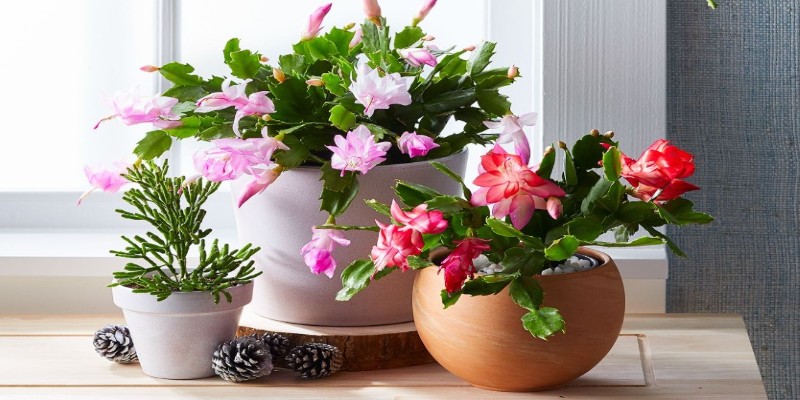A holiday cactus in full bloom is a vibrant symbol of the season, bringing bursts of pink, red, or white to brighten winter's gloom. Yet, many plant owners struggle to keep theirs healthy, let alone coax them into blooming again. Some flourish effortlessly, while others refuse to flower despite careful attention.
Success with a holiday cactus isn’t luck—it’s about meeting its unique needs. Unlike desert cacti, these plants come from Brazil’s cloud forests, where they thrive in humid, shaded conditions. Mastering the right balance of light, water, and temperature transforms them into resilient, long-lasting houseplants. Once understood, a holiday cactus becomes one of the most rewarding plants to grow year after year.
To help a holiday cactus thrive, the climate should be as close as it can be to its original state. Bright light is a must for them. Direct sun, particularly in summer, can cause their leaves to become red or even burned. A north- or east-facing window is the best, but if you only have a south one, using a sheer curtain in between the sun and plant will suffice.
Humidity plays a big role in the plant’s health. Unlike desert cacti, holiday cacti absorb moisture from the air, so a dry home can make them struggle. If your home is particularly dry, placing a shallow dish of water near the plant or misting it occasionally can help. Another option is to keep the cactus in a naturally humid room like a bathroom or kitchen, as long as it still receives enough light.
Soil is also important. Holiday cacti require a draining mix to avoid root rot. A mixture of potting soil and perlite or orchid bark is good. Regular cactus soil can be too dry and may not retain enough water for these plants to grow. Good drainage is essential, so ensure the pot has holes at the bottom. Remaining in water for too long is one of the quickest methods to kill a holiday cactus.
One of the biggest mistakes people make with holiday cacti is treating them like desert cacti. These plants don’t like drying out completely. The goal is to keep the soil slightly damp but never soggy. Watering once the top inch of soil feels dry is a good rule of thumb. In winter, when the plant is in bloom, it may need slightly more water, but overwatering can cause root rot. If unsure, it’s better to underwater slightly rather than risk soaking the roots.

Fertilizing is another factor in holiday-cactus success. During the growing season (spring and summer), a balanced liquid fertilizer once a month helps keep the plant strong. In fall, reducing fertilizer encourages blooming. Some gardeners swear by high-phosphorus fertilizers to promote better flowers, but a general-purpose houseplant fertilizer usually works just fine.
Temperature also plays a role in when and how often a holiday cactus blooms. These plants need a period of cooler temperatures to trigger flower production. In the fall, keeping them in a room with temperatures around 50-60°F (10-15°C) for a few weeks signals the plant to set buds. A common mistake is keeping the plant in a warm room all year, which can prevent it from blooming.
One of the biggest frustrations with holiday cacti is that they don’t always bloom as expected. Some years, they produce a spectacular show, while other times, they stubbornly refuse to flower at all. The secret to consistent blooming lies in a combination of darkness, temperature, and care.
Holiday cacti are triggered to bloom by shorter days and cooler temperatures. About six to eight weeks before you want flowers, start giving the plant 12-14 hours of darkness every night. This doesn’t mean total darkness, but it should be in a room without artificial light at night. Some people even place their cactus in a closet for part of the evening to ensure it gets enough darkness.
At the same time, the plant should be kept in a slightly cooler environment. The combination of longer nights and cooler temperatures tells the plant it’s time to produce buds. Once buds start to form, move the plant back to a brighter spot but avoid sudden changes in temperature, which can cause the buds to drop.
Even with the best care, some plants might not bloom every year, especially if they’ve been moved around too much. Holiday cacti don’t like sudden changes, so once they start forming buds, it’s best to keep them in one place.
A well-cared-for holiday cactus can thrive for decades, with some plants being passed down through generations. The secret to longevity lies in avoiding common mistakes like overwatering, poor lighting, and skipping the crucial rest period before blooming.

Repotting should only be done when necessary, typically every three to five years. These plants prefer being slightly root-bound, and frequent repotting can cause unnecessary stress. Always use a well-draining soil mix and avoid oversized pots, as excess moisture can lead to root rot.
Pruning helps maintain a healthy shape and encourages more blooms. If a cactus becomes too leggy, trimming a few segments in early spring promotes bushier growth. These cuttings can even be propagated to grow new plants.
Pests are rare but can occur, especially if the plant is overwatered. Mealybugs and fungus gnats are the most common culprits. Regularly inspecting leaves and soil helps catch issues early, ensuring a long and healthy life for your cactus.
Caring for a holiday cactus is simpler than it seems once you understand its needs. With the right balance of light, water, and temperature, this plant rewards you with vibrant blooms year after year. Unlike other houseplants, it thrives on routine and patience, needing a cool period before flowering. When given proper care, a holiday cactus can live for decades, becoming a cherished part of seasonal traditions. A little effort ensures it remains a stunning, blooming centerpiece for years to come.

By Eleanor/Mar 19, 2025

By Kristina Cappetta/Apr 28, 2025
By Eleanor/Nov 09, 2024

By Frederica/Feb 21, 2024

By Vicky Louisa/Feb 19, 2025

By Kristina Cappetta/May 28, 2025

By Peter Evans/Apr 06, 2024

By Sid Leonard/Oct 10, 2024

By Eleanor/Feb 21, 2024

By Sid Leonard/Jun 17, 2025

By Lucy Lee/Feb 28, 2024

By Triston Martin/Feb 10, 2024